The Creative Self: Experiencing Literature through the Inward Eye
Giovanna Zappu, Italy
Giovanna Zappu holds a Bachelor of Arts degree (hons) from Sydney University, Australia, and Diploma of Education from Sydney Teacher’s College. She teaches English language and literature in a liceo scientifico, Cagliari, and literature methodology for the SSIS ( Scuola di Specializzazione per gli Insegnanti della Scuola Secondaria). She has been a teacher trainer for lingua 2000. She has written a Reading Guide and Teacher’s Guide to "The Importance of Being Earnest" by Oscar Wilde (Loescher ), and is co-author of "Creatività e Analisi del Testo Poetico" (La Nuova Italia). She is particularly interested in drama and has written and put on stage "Mac&Beth ( A Midsummer Nightmare) and "Whatever Happened to Baby Dot?"
E-mail: jonatale@alice.it
Menu
Blow Up & Rosencrantz and Guildenstern Are Dead
The Inward Eye and Creativity
Recreating the Text
Textual Intervention
Trapped inside a literary work
Examples of Textual Intervention
The Inward Ear
Differentiating students’ work in mixed ability EFL classes
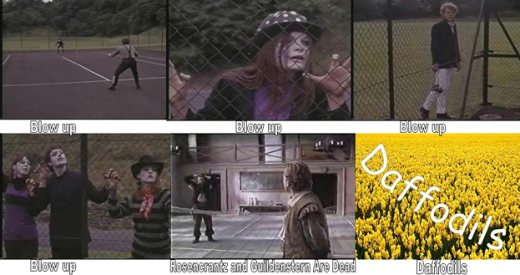
Imagine a sequence of two tennis scenes, one from Antonioni’s film "Blow Up" and the other from Stoppard’s "Rosencrantz and Guildenstern Are Dead" and try to establish what the connection may be between tennis and " Experiencing Literature through the Inward Eye".
In creating links between the two tennis scenes, I’ve experimented with what I consider to be two of the most important characteristics underlying creativity:
- firstly the ability to make connections between apparently unconnected ideas
- secondly, seeing things in the mind's eye, the imagination or inward eye.
The link between tennis and the inward eye came to me quite serendipitously on reading an article on Gianni Clerici ex tennis player, sport journalist and writer who applies the stream of consciousness to tennis, for he considers what we see going on between the players as merely the result of what's going on inside their heads.
And it is this very idea of going inside, of connecting the visible to the invisible, the ability to create associations through stream of consciousness or brainstorming which is at the basis of the process of interpretation, where we play with meaning by asking questions...which brings us to the second link, the tennis match between Rosencrantz and Guildenstern, the question match, where asking questions (the process) is more important than the answers, since it is the questions that provide us with the tools to explore the undisclosed meanings we are looking for.
There is no tennis ball in the two matches, the whole game is played and seen through the imagination and furthermore the idea of a game, of playing, provides us with another important link with our childhood where playing games and the imagination are topmost.
Another link with the film "Blow Up" regards the process of blowing up pictures by magnifying them larger and larger to poster size which in the film leads to the discovery of a murder which was invisible to the naked eye. The camera in the film is the inward eye, the imagination, which allows us not only to see beyond the apparent but to formulate questions to explore the paths of perception, the paths of seeing.
If we apply this technique to any small insignificant part of a text which is in the mere background, we may be surprised with what may come to the surface regarding the interpretation of the whole text.
An example of this technique can be Rosencrantz and Guildenstern, two secondary characters from Shakespeare's "Hamlet" which, blown up, become the protagonists in Stoppard's play to bring to the foreground the absurd characteristic already inherent in Shakespeare's tragedy; thus from tragedy we shift into the theatre of the absurd to update Shakespeare through Beckett. George Steiner says that the best way to understand art is through art itself; for example, the best way to understand "Middlemarch" by George Eliot is by reading "The Portrait of a Lady" by Henry James.
Therefore if the whole tennis scene were de-contextualized and that is, if there were no tennis court and no tennis net and if we as spectators had no foreknowledge of tennis, then the movement of the players could suggest a kind of tribal dance ( and if you look at it while listening to a piece of Yothu Yindi aboriginal music, it will render it all the more convincing ) thus adding an unusual interpretation to the game of tennis as a celebration of the need to recall our ancestral past or the need to recreate it.
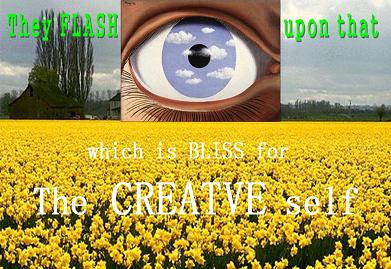
The "inward eye" is obviously associated with Wordsworth’s "inward eye" which when he goes back home allows him to relive his experience and through "emotions recollected in moments of tranquillity" to CREATE …key word for interpreting the poem "I Wandered Lonely as a Cloud" and the main reason why I chose this poem to illustrate creative techniques for interpreting the literary text.
The poem itself can be summed up in three words : Experience-Memory-Creation.
If we want to foster creativity in our students and the ability to interpret texts by creating parallel texts, then the hook can be to engage them in enjoyable tasks (serious fun), for only if they are involved and highly motivated will they be able to recall more easily what they have explored or learnt (we usually want to relive what we enjoy). Consequently and through association with other reading experiences already stored in their minds, they will be able to create mental hypertexts to bring to the surface 10000 other interpretations of the base text.
Another important feature of creativity can be found in the image of a cat chasing its tail. If we want to break routine, or addiction to text books with ready made solutions, then we must awaken the mind’s attention from "the lethargy of custom" which will allow us to see things and explore different paths as if for the first time.
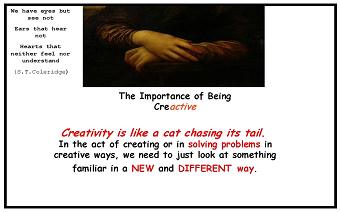
Consequently if we are prepared to explore the longer paths rather than take the short cuts, we will certainly run into Lady Serendipity, the unexpected, which will spark off other creative connections to develop in an endless search for new and surprising discoveries.
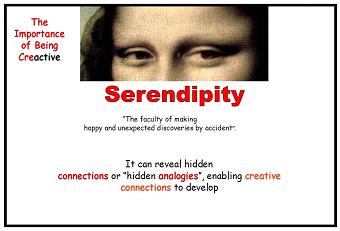
The hook that will encourage our students to take the longer paths and avoid the short cuts can be found in the word play "giocando–gioconda", in other words playing and fun, serious fun if you like. The best way to motivate them and maintain their interest is by engaging their creative self in playing with the text to find the key to go inside to recreate it through the imagination.

If we consider that any writer whether big or small when s/he writes is faced with the many crossroads which represent the choices that have to be made before taking the many paths that lie ahead of the creative process, then the end product, poem or novel as Steiner says, houses within it the remembrance of what it could have been or some of the paths that the writer didn't take but could have.
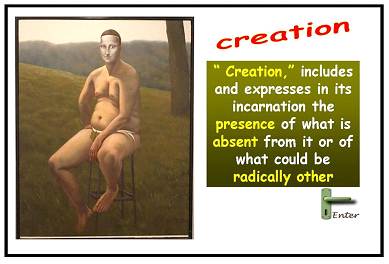
Therefore the reader should look at the finished product as "unfinished", as something to explore in what ways it could have been completely different
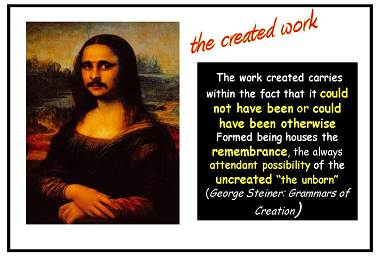
Therefore the reader should be involved in the creative process by becoming a producer of texts
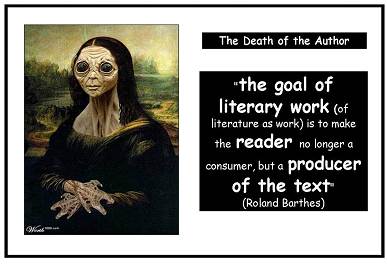
Since the reader can be regarded as a magnetic field where all texts s/he has uploaded converge....the SPACE where the text is constantly REVISED REWRITTEN REINTERPRETED.
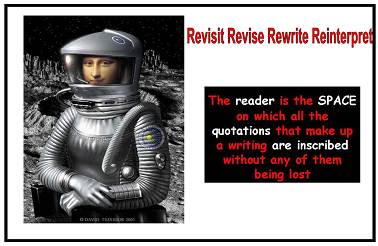
And in the end the pieces will fit together just like in a puzzle through further associations with other reading experiences to provide the missing parts which will allow the reader to continue to play, maybe with the mystery of the Gioconda.
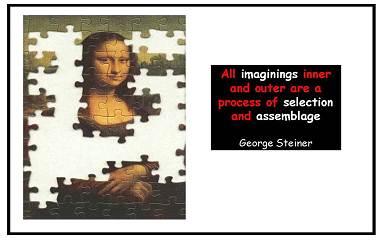
How in concrete terms can all this come about ? According to Rob Pope fundamentally all imaginative writings spring from one question...what if the text were different? and the process of providing paths to answer these questions consists in getting the reader on the inside of the text to write one's way into reading.
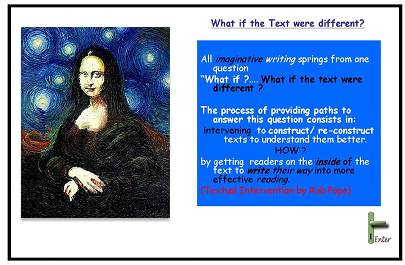
There are many ways to do this, for example, by giving voice to the muted voice
We have an example of this in Jean Rhys's novel "Wide Sargasso Sea" where Bertha, the mad woman in the attic in "Jane Eyre" by Charlotte Bronte, is given voice and we readers are given the possibility of reading Bronte's novel from another perspective and answer it back by asking why Bronte left the character Bertha in the background? ...why was she less important to her than Rhys? …what could have changed in the novel if the author had provided us with the social historical background to Bertha's madness?
What would the change have brought about?

Going inside the text as Pope suggests establishes a link between the writer and reader in a relationship of co-authorship. We are not led away from the base text but led back into it through the many questions that the intervention poses regarding the base text and by accounting for the result that the change has produced.
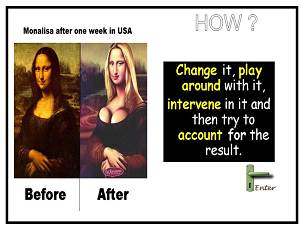
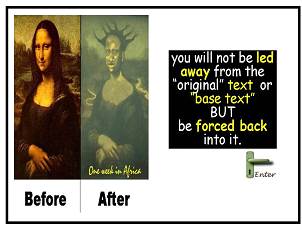
Some suggestions for textual intervention:
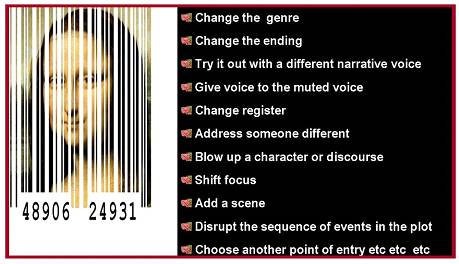
It is by literally going inside the text that in Jasper Fforde's novel "The Eyre Affair", the scientist Mycroft who has created a machine which can modify any part of a novel with the help of his bookworms, where heroines such as Jane Eyre can be abducted and the readers kept on tenterhooks for they don’t know how it will end. In this novel Mycroft's wife Polly Next becomes trapped inside Wordsworth’s poem "I Wandered Lonely as a Cloud" and she actually comes face to face with Wordsworth who is also inside his poem.
The novel poses the question, what if we could go inside the poem, what if we had been present at one of the many crossroads that the poet took before the final edition. We may very well ask, what led Wordsworth to choose cloud instead of cow? I wandered lonely as a cloud/cow. What other changes would he have made if he had kept cow and how differently will we readers imagine his walk if we picture a cow instead of a cloud? What was Wordsworth himself playing with when he made his final choice?
The Glittering Eye
It is by playing with these hypotheses and with Pope's textual intervention techniques that we also might try to imagine Wordsworth trapped inside Coleridge's Ancient Mariner at the point of the mariner’s epiphany. How would he express his awareness of the beauty of nature in the role of the ancient mariner.
Flowers Flowers everywhere
Floating to the brim
Flowers Flowers everywhere
My very soul did swim
The Roving Eye
Or through association with the flower motif we can continue our textual intervention and imagine Wordsworth trapped inside Molly Bloom's interior monologue at the point where the flowers begin to thread her stream of consciousness, the point where Leopold Bloom proposes to her. Would it be far too fetched or going beyond the imagination to see Wordsworth’s encounter with the daffodils as a spiritual orgasm ?
|
the day I wandered lonely like when I saw beside the lake beneath the trees a crowd a host of what are they called like the stars yes golden daffodils fluttering yes dancing yes in the breeze ten thousand tossing their heads yes in sprightly dance yes the waves danced but they I could not but be gay I gazed yes gazed and gazed but when I lie they flash upon my yes and then yes bliss yes then my yes heart with pleasure fills yes and yes and dances yes with the daffodils YES
|
The Immortal Eye
What if he were trapped inside Blake's "Tyger", the poem I mean.
How would he express his feelings regarding the mystery of creation.
Daffodils ! Daffodils ! beneath the trees
Fluttering and dancing in the breeze
What Immortal hand or eye
Did frame thy joyful symmetry
|
Graffiti
Or if we continue with this game of metamorphosis, with the "what if ?" hypotheses, if it were a graffiti what message would we see written on the wall?
What is brought to the foreground is the capacity of poetry, more than drugs, to make one feel high and creative or as in the second graffiti where the flowers are no longer "tossing their heads in sprightly dance" but tossing and turning in their beds, tormented by the pick-nickers who pick and nick the flowers destroying the harmony of nature.
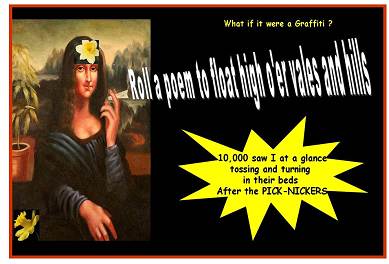
What if it were a Haiku ?
The milky way used to refer to the constellation in Wordsworth’s poem ("continuous as the stars that shine and twinkle on the milky way") here becomes the pathway for the flowers to go home which is both the poet's house but also the mental framework which sets the scene for nesting-creating the poem,. Moreover the golden daffodil "sheets" are both the bed (also flower bed) and the sheets of paper used to compose the poem.
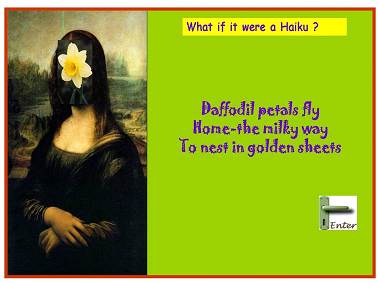
What if it were a limerick ?
A poet once claimed he had seen
Daffodils dance on the green
When asked could they tip tap?
He lifted his top hat
And made them appear on the screen
In the limerick, the poet's capacity to transform the ordinary reality through the imagination and recreate the scene like a magician is brought to the foreground.
The Eye Witness
What if it were written from the point of view of the muted voice (the flowers)
Giving voice to the muted voice; the flowers looking at Wordsworth looking at them.
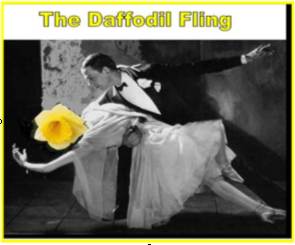
We were fluttering and dancing in the breeze
That sweeps the clouds free above the tree
When all at once we saw a shadow
Wandering slowly o’er the meadow
Alone he walked as in a daze
And believe us we were quite amazed
For ten thousand blushes made us red
From his continuous insistent gaze
But when he bent and "Let’s dance" he said
We then realized he was quite insane
Not to accept we thought in vain
But in sprightly dance to entertain
Gay he felt in our company
But happier we when he took leave
For oft when in our natural pose
It’s hard to find our sweet repose
Away from furtive idi-ots
Who pick us for their
love-me-not
Relieved the Fred Astaire of our ballet
Did not consider us a take-away
To stick inside a vase and watch us wear away
For when the blissful dance did stop
His inward eye stole a shot
To fill his home with a golden spring
When he rewinds the daffodil fling
What if it were an advertisement? What would it be ?
Inspired by Adrian Henri’s "The New fast Automatic Daffodil" based on a cut and paste technique of a car brochure and Wordsworth’s poem, I experimented with one of my classes a textual intervention based on "what if it were an advertisement" ? what would it advertise?
A group of students created a video ad for a perfume against the death Scentence.
The scene takes place in a gaol. The prisoner expresses his last wish to have a whiff of his favourite perfume before the execution …the scent allows him to have a flash back to happier days when he was free and dancing in a daffodil field. The scene then shifts back to the gaol where the prisoner rubs off the wall the graffiti "mind forged manacles" and substitutes it with "Against the death SCENTence". Happy memories are recalled in a Proustian way.
What if it were an e-mail ?
The following textual interventions were carried out by my SSIS students.
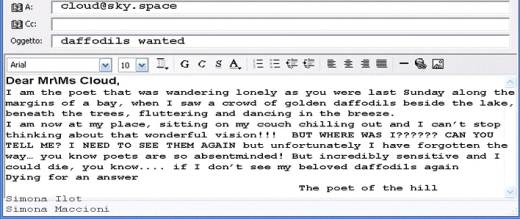
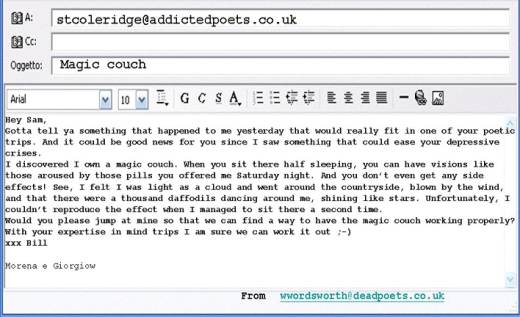
If we teachers, together with our students ( creativity is a type of learning process where the teacher and pupil are located in the same individual) want to break loose from the "mind forged manacles" that imprison the imagination, a resource which has too often been left in the background after primary school, then we must also learn to listen with our inward ear and bring to light our "creative selves" and as an experiment we can try to imagine the music that may have inspired Wordsworth’s daffodils to dance .
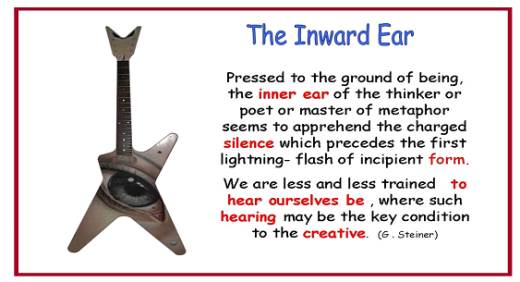
"Heard melodies are sweet
but those unheard are sweeter"
John Keats
Pope, Rob (1995) Textual Intervention Routledge, London
Pope, Rob Creativity: Theory, History, Practice, London & New York: Routledge, (March 2005).
Steiner, George (1989) Real Presences, The University of Chicago Press., Chicago
Steiner, George (2001) Grammars of Creation, Yale University Press, U.S.A.
Fforde Jasper (2001) The Eyre Affair, Hodder & Stoughton, London
Barthes Roland ; The Death of the Author
I Wandered Lonely as a Cloud by W.Wordsworth

Please check the Creative Methodology for the Classroom course at Pilgrims website.
Please check the Teaching through Art and Music course at Pilgrims website.
Please check the What’s New in Language Teaching course at Pilgrims website.


|